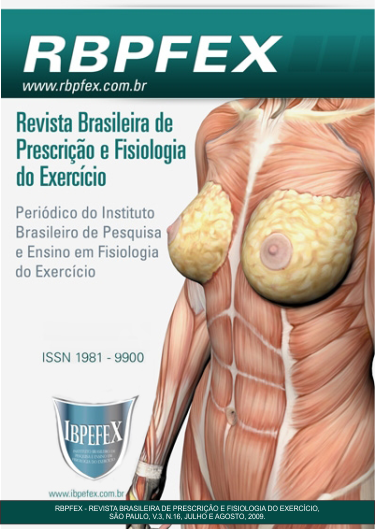Comparative study of acute effect on blood sugar in water gym practitioner’s elderly
Abstract
The objective of this study was to investigate the behavior of the glucose in acute exercise of Aqua aerobic in practicing elderly. In one shows of 9 subjects (9 women) the age of 60 ± 8, average weight 76.26 kg and average height of 157 cm, applied to the same group two lessons, the first lesson, aerobic with rectangular load without equipment and the second lesson, interval with the use of gloves, scale of Borg for the control the intensity of the exercise and anamnese investigation of the 24-hour, the subjects were in twelve-hour fast when collected glucose capillary before and after the two types of the physical activity. The samples of blood had been analyzed by package SPSS 13.0 applied a T-test: collect one: the average the glucose in the pre-test was 78.22 ± 4.44; s.1.48; the average the glucose in the post-test was 69.67 ± 6.40; s. 2.13; collect two: the average the glucose in the pre-test 70.67 ± 6.42; s. 2.14; the average the glucose in the post-test 62.67 ± 6.36; s. 2.12. The significant level adopted in this study was p > 0.05. Perhaps it did not have significant differences in the reply of the glucose enters the two types of the physical activity, for being the physical execution relatively limited for this group, however had difference in the relation of collect one. Being able to conclude that the aqua aerobics for the elderly seems to favor the control of the glucose, acting as prevention to the development of the Diabetes Mellitus and Metabolic Syndrome.
References
- Aboarrage, N. Hidro treinamento. Rio de Janeiro: Shape. 2003.
- ACMS - Guidelines for Exercise Testing and Prescription. Philadelphia – USA. 7a. Edição. 2006. P. 237 - 250.
- Almeida, M.N. Hidroginástica Prática Corporal Voltada à Promoção da Saúde do Idoso. Rio de Janeiro. V. 8. P. 52. 1999.
- Alves, R.V.; Motta, J.; Costa, M.C.; Alves, J.B. Aptidão física relacionada à saúde de idosos: influência da hidroginástica. Revista Brasileira de Medicina do Esporte. Niterói. Vol. 10. Num. 1. Jan./fev. 2004
- Brasil, Ministério da Saúde. Estatuto do Idoso. Brasília. Num. 1. 2003
- Caromano, F. A.; Filho, M. R.F.T.; Candeloro, J.M. Efeitos Fisiológicos da Imersão e do Exercício na Água. Revista Fisioterapia Brasil. São Paulo. Num. 1. Jan./2003
- Denadai, B.S. e colaboradores. Avaliação Aeróbia: determinação indireta da resposta do lactato. Rio Claro. Motrix. 2000 P. 65-88.
- Evans, E. M.; Racette, S. B.; Peterson, L. R.; Villareal, D. T.; Greiwe, J. S.; Holloszy, J. O. Aerobic power and insulin action improve in response to endurance exercise training in healthy 77–87 yr olds Journal of Applied Physiology. Vol. 98. p. 40-45. 2005.
- Garret JR, W.E.; Kirkendall, D. T. e colaboradores; A Ciência do Exercício e dos Esportes. Porto alegre. Artmed. 2003. p. 23-29 e 302- 308
- Guyton, A.C. Tratado de Fisiologia Médica. 7ª. Edição. Rio de Janeiro. Guanabara. 1989. p. 624-630
- Leite, P.F. Exercício, Envelhecimento e Promoção da Saúde. 1ª. Edição. Belo Horizonte. Health.1996. p. 17-27.
- MacArdle, D.M.; Katch, F.I.; Katch. V.L. Fisiologia do Exercício. 5ª. Edição. Rio de Janeiro. Guanabara. 2003. p. 134 -159 e 892-918.
- Matsudo, S.M.; Matsudo, V.K. Prescrição e benefícios da Atividade física na Terceira Idade. Rev. Brás. Ciência e Movimento. Vol. 6. Num. 4. Out. 1992.
Authors who publish in this journal agree to the following terms:
- Authors retain the copyright and grant the journal the right of first publication, with work simultaneously licensed under the Creative Commons Attribution License BY-NC which allows the sharing of the work with acknowledgment of the authorship of the work and initial publication in this journal.
- Authors are authorized to enter into additional contracts separately for non-exclusive distribution of the version of the work published in this journal (eg, publishing in institutional repository or book chapter), with acknowledgment of authorship and initial publication in this journal.
- Authors are allowed and encouraged to post and distribute their work online (eg, in institutional repositories or on their personal page) at any point before or during the editorial process, as this can bring about productive change as well as increase impact and impact. citation of published work (See The Effect of Free Access).






